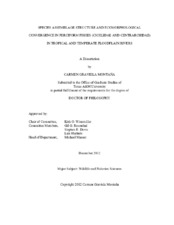| dc.contributor.advisor | Winemiller, Kirk O | |
| dc.creator | Montana, Carmen 1976- | |
| dc.date.accessioned | 2013-03-14T16:12:31Z | |
| dc.date.available | 2014-12-12T07:18:55Z | |
| dc.date.created | 2012-12 | |
| dc.date.issued | 2012-08-16 | |
| dc.date.submitted | December 2012 | |
| dc.identifier.uri | https://hdl.handle.net/1969.1/148090 | |
| dc.description.abstract | In this study, I used two independent perciform lineages (Neotropical Cichlidae and Nearctic Centrarchidae) to examine patterns of species richness and species coexistence a two spatial scales (e.g., macrohabitat and mesohabitat) and to examine inter-faunal patterns of ecomorphological convergence. The study was conducted during the low-water periods in four lowland rivers: the Cinaruco in Venezuela, the Tambopata in Peru, and the Neches and the Brazos rivers in Texas (USA). These rivers were chosen because of their similar characteristics, in terms of geomorphology, sediments, and water quality. The Cinaruco River and the Neches River have clear slightly-stained waters, whereas the Tambopata and the Brazos River have turbid waters with high loads of suspended sediments. I used morphological approaches as a surrogate to investigate patterns of species distribution in niche space, and predict patterns of species richness at different spatial scales. Despite high variation in the number of species in these two perciform assemblages, morphological analysis based on the means and standard deviations of nearest neighbor distance (NND) and mean distance to centroid (CD) revealed similar trends of morphological similarity in relation to species richness. Comparison of observed versus randomized data mesohabitat scale for all four rivers generally supported the niche expansion model of response to increase in species richness. At the scale of mesohabitats within rivers, most species assemblages appear to be organized by competitive interactions in accordance with the niche expansion model. The tropical species-rich Cinaruco River revealed particularly strong support for the niche expansion model. Intercontinental comparison of functional morphology and diets based on analysis of stomach contents and stable isotope ratios indicated broad morphological and dietary overlap between cichlid and centrarchid assemblages. For the most part, morphological ordinations showed that the two groups have diversified in a parallel manner within the confines of ram-suction modes of prey ingestion. This study concludes that even though differences are observed in historical and stochastic factors structuring fish assemblages in different geographic regions, consistent patterns of convergence at the species and assemblage levels results from natural selection under similar environmental conditions. | en |
| dc.format.mimetype | application/pdf | |
| dc.subject | Nearctic. | en |
| dc.subject | Neotropic | en |
| dc.subject | null models | en |
| dc.subject | morphological convergence | en |
| dc.subject | Cichlidae | en |
| dc.subject | Centrarchidae | en |
| dc.subject | Assembly rules | en |
| dc.title | Species Assemblage Structure and Ecomorphological Convergence in Perciform Fishes (Cichlidae and Centrarchidae) in Tropical and Temperate Floodplain Rivers | en |
| dc.type | Thesis | en |
| thesis.degree.department | Wildlife and Fisheries Sciences | en |
| thesis.degree.discipline | Wildlife and Fisheries Sciences | en |
| thesis.degree.grantor | Texas A&M University | en |
| thesis.degree.name | Doctor of Philosophy | en |
| thesis.degree.level | Doctoral | en |
| dc.contributor.committeeMember | Rosenthal, Gil G | |
| dc.contributor.committeeMember | Davis, Stephen E | |
| dc.contributor.committeeMember | Hurtado, Luis | |
| dc.type.material | text | en |
| dc.date.updated | 2013-03-14T16:12:31Z | |
| local.embargo.terms | 2014-12-01 | |


